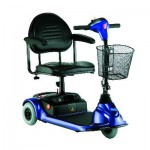3-Wheel & 4-Wheel Scooter Safety


  |
VS |   |
| Provides more stability than full range maneuvering | Provides more maneuverability in tight spaces | |
| A scooter can tip in one of four ways: 1. When the driver steps on the edge of the platform the scooter can tip sideways. 2. Traversing a side slope the scooter can tip over sideways. 3. Going up a hill the scooter can tip over backwards. 4. Turning sharply at speed can cause the scooter to tip sideways. |
||
| Situation 1. Standing on edge of platform, scooter tips sideways. This is related to the amount the platform overhangs the wheelbase and also the weight of the scooter relative to the driver. If the driver stands on the edge of the platform to get on and off and the platform overhangs the wheelbase by a large amount then the long lever arm will cause the scooter to tip sideways. If the client is heavy and the scooter light the tendency to tip will be increased. If the driver places his or her foot within the wheelbase no scooter tips. |
||
| Situation 2. Traversing a side slope the scooter can tip sideways. The side slope stability is directly related to the wheelbase width in line with the center of gravity. Four wheel scooters are not really affected by moving the seat forwards and backwards since the width of the wheelbase is the same for the length of the scooter. The triangular wheelbase of the three wheel scooter makes the seat location quite critical as well as the seated posture of the driver. The farther forward the center of gravity on a three wheel scooter the less lateral stability it has |
||
| A higher the center of gravity on either scooter will make it more likely to tip. | ||
| Situation 3. Going up hill, scooter can tip backwards. This stability issue has very little to do with the scooter having three or four wheels. Tendency to flip back is only affected by the location of center of gravity. The further back and higher the c of g the less the angle at which a scooter will tip. Anti tippers are employed on both types of scooter to prevent tipping too far. |
||
| Situation 4. Turning sharply at speed can cause the scooter to tip sideways. Dynamic stability is affected by turning radius and the width of the wheelbase. During this maneuver the center of gravity is displaced forwards and laterally i.e., diagonally forwards. If it moves outside the wheelbase the scooter will lift a back wheel and the driver could be pitched out. This is where a four-wheeled scooter has two inherent advantages. Firstly, the wheelbase is wider at the front and secondly due to the steering linkages the front wheels cannot be turned as sharply as a three wheeler and the displacing force is less and in a more forward direction. | ||



 (800) 437-3677
(800) 437-3677